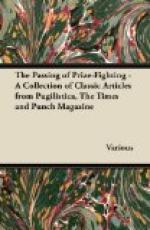Physiology.—The body, face, and arms of the opera-dancer present no peculiarities above the rest of his species; and it is to his lower extremities alone that we must look for distinguishing features. As our researches extend downwards from head to foot, the first thing that strikes us is a protuberance of the ante-occipital membranes, so great as to present a back view that describes two sides of a scalene triangle, the apex of which projects posteriorly nearly half way down the figure. That a due equilibrium may be preserved in this difficult position (technically called “the first"), the toes are turned out so as to form a right angle with the lower leg. Thus, in walking, this curious being presents a mass of animated straight lines that have an equal variety of inclination to a bundle of rods carelessly tied up, or to Signor Paganini when afflicted with the lumbago.
Habits.—The habits of the opera-dancer vary according as we see him in public or in private life. On the stage he is all spangles and activity; off the stage, seediness and decrepitude are his chief characteristics. It is usual for him to enter upon his public career with a tremendous bound and a hat and feathers. After standing upon one toe, he raises its fellow up to a line with his nose, and turns round until the applause comes, even if that be delayed for several minutes. He then cuts six, and shuffles up to a female of his species, who being his sweetheart (in the ballet), has been looking savage envy at him and spiteful indignation at the audience on account of the applause, which ought to have been reserved for her own capering—to come. When it does, she throws up her arms and steps upon tiptoe about three paces, looking exactly like a crane with a sore heel. Making her legs into a pair of compasses, she describes a circle in the air with one great toe upon a pivot formed with the other; then bending down so that her very short petticoat makes a “cheese” upon the ground, spreads out both arms to the roues in the stalls, who understand the signal, and cry “Brava! brava!!” Rising, she turns her back to display her gauze jupe elastique, which is always exceedingly bouffante: expectorating upon the stage as she retires. She thus makes way for her lover, who, being her professional rival, she invariably detests.
It is singular that in private life the habits of the animal differ most materially according to its sex. The male sometimes keeps an academy and a kit fiddle, but the domestic relations of the female remain a profound mystery; and although Professors Tom Duncombe, Count D’Orsay, Chesterfield, and several other eminent Italian-operatic natural historians, have spent immense fortunes in an ardent pursuit of knowledge in this branch of science, they have as yet afforded the world but a small modicum of information. Perhaps what they have learned is not of a nature to be made public.




